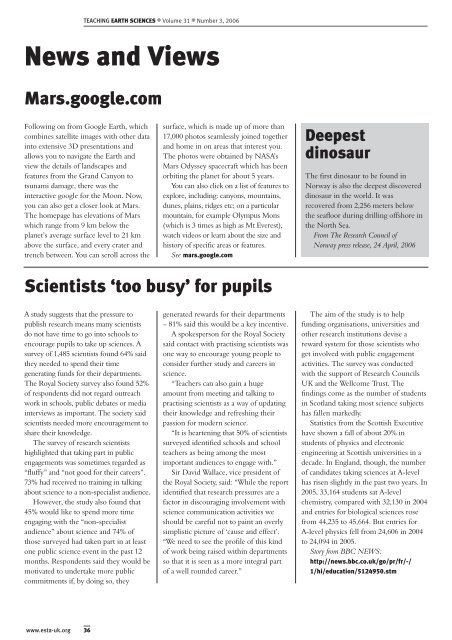teaching - Earth Science Teachers' Association
teaching - Earth Science Teachers' Association
teaching - Earth Science Teachers' Association
Create successful ePaper yourself
Turn your PDF publications into a flip-book with our unique Google optimized e-Paper software.
TEACHING EARTH SCIENCES ● Volume 31 ● Number 3, 2006<br />
News and Views<br />
Mars.google.com<br />
Following on from Google <strong>Earth</strong>, which<br />
combines satellite images with other data<br />
into extensive 3D presentations and<br />
allows you to navigate the <strong>Earth</strong> and<br />
view the details of landscapes and<br />
features from the Grand Canyon to<br />
tsunami damage, there was the<br />
interactive google for the Moon. Now,<br />
you can also get a closer look at Mars.<br />
The homepage has elevations of Mars<br />
which range from 9 km below the<br />
planet’s average surface level to 21 km<br />
above the surface, and every crater and<br />
trench between. You can scroll across the<br />
surface, which is made up of more than<br />
17,000 photos seamlessly joined together<br />
and home in on areas that interest you.<br />
The photos were obtained by NASA’s<br />
Mars Odyssey spacecraft which has been<br />
orbiting the planet for about 5 years.<br />
You can also click on a list of features to<br />
explore, including: canyons, mountains,<br />
dunes, plains, ridges etc; on a particular<br />
mountain, for example Olympus Mons<br />
(which is 3 times as high as Mt Everest),<br />
watch videos or learn about the size and<br />
history of specific areas or features.<br />
See mars.google.com<br />
Deepest<br />
dinosaur<br />
The first dinosaur to be found in<br />
Norway is also the deepest discovered<br />
dinosaur in the world. It was<br />
recovered from 2,256 meters below<br />
the seafloor during drilling offshore in<br />
the North Sea.<br />
From The Research Council of<br />
Norway press release, 24 April, 2006<br />
Scientists ‘too busy’ for pupils<br />
A study suggests that the pressure to<br />
publish research means many scientists<br />
do not have time to go into schools to<br />
encourage pupils to take up sciences. A<br />
survey of 1,485 scientists found 64% said<br />
they needed to spend their time<br />
generating funds for their departments.<br />
The Royal Society survey also found 52%<br />
of respondents did not regard outreach<br />
work in schools, public debates or media<br />
interviews as important. The society said<br />
scientists needed more encouragement to<br />
share their knowledge.<br />
The survey of research scientists<br />
highlighted that taking part in public<br />
engagements was sometimes regarded as<br />
“fluffy” and “not good for their careers”.<br />
73% had received no training in talking<br />
about science to a non-specialist audience.<br />
However, the study also found that<br />
45% would like to spend more time<br />
engaging with the “non-specialist<br />
audience” about science and 74% of<br />
those surveyed had taken part in at least<br />
one public science event in the past 12<br />
months. Respondents said they would be<br />
motivated to undertake more public<br />
commitments if, by doing so, they<br />
generated rewards for their departments<br />
– 81% said this would be a key incentive.<br />
A spokesperson for the Royal Society<br />
said contact with practising scientists was<br />
one way to encourage young people to<br />
consider further study and careers in<br />
science.<br />
“Teachers can also gain a huge<br />
amount from meeting and talking to<br />
practising scientists as a way of updating<br />
their knowledge and refreshing their<br />
passion for modern science.<br />
“It is heartening that 50% of scientists<br />
surveyed identified schools and school<br />
teachers as being among the most<br />
important audiences to engage with.”<br />
Sir David Wallace, vice president of<br />
the Royal Society, said: “While the report<br />
identified that research pressures are a<br />
factor in discouraging involvement with<br />
science communication activities we<br />
should be careful not to paint an overly<br />
simplistic picture of ‘cause and effect’.<br />
“We need to see the profile of this kind<br />
of work being raised within departments<br />
so that it is seen as a more integral part<br />
of a well rounded career.”<br />
The aim of the study is to help<br />
funding organisations, universities and<br />
other research institutions devise a<br />
reward system for those scientists who<br />
get involved with public engagement<br />
activities. The survey was conducted<br />
with the support of Research Councils<br />
UK and the Wellcome Trust. The<br />
findings come as the number of students<br />
in Scotland taking most science subjects<br />
has fallen markedly.<br />
Statistics from the Scottish Executive<br />
have shown a fall of about 20% in<br />
students of physics and electronic<br />
engineering at Scottish universities in a<br />
decade. In England, though, the number<br />
of candidates taking sciences at A-level<br />
has risen slightly in the past two years. In<br />
2005, 33,164 students sat A-level<br />
chemistry, compared with 32,130 in 2004<br />
and entries for biological sciences rose<br />
from 44,235 to 45,664. But entries for<br />
A-level physics fell from 24,606 in 2004<br />
to 24,094 in 2005.<br />
Story from BBC NEWS:<br />
http://news.bbc.co.uk/go/pr/fr/-/<br />
1/hi/education/5124950.stm<br />
www.esta-uk.org<br />
36
















